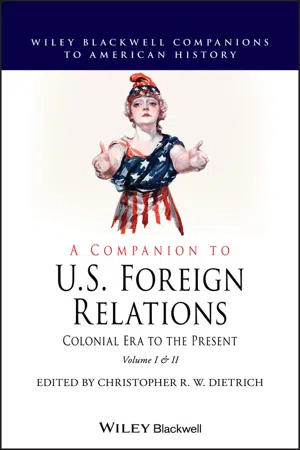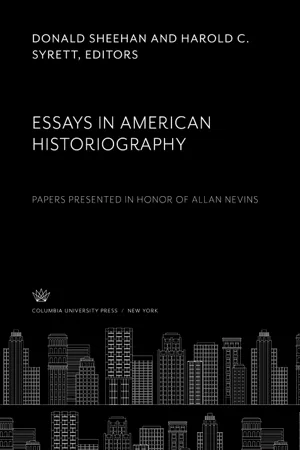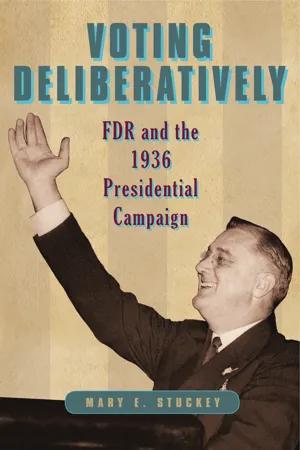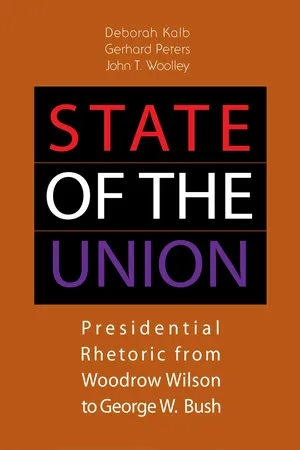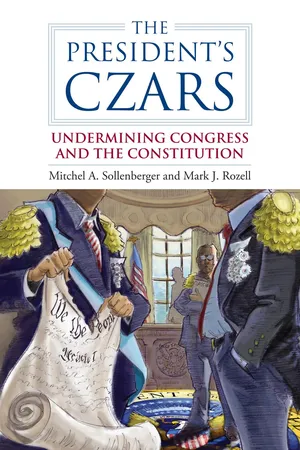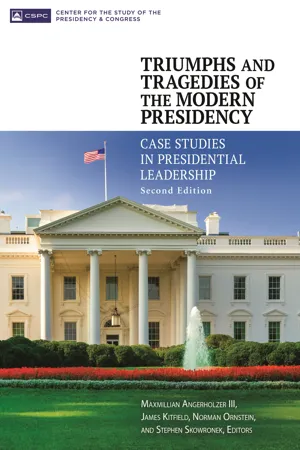History
Roosevelt Administration
The Roosevelt Administration refers to the presidency of Franklin D. Roosevelt, who served from 1933 to 1945. This period was marked by significant government intervention in the economy to combat the Great Depression, as well as the implementation of social welfare programs through the New Deal. Roosevelt's leadership also played a crucial role in guiding the United States through World War II.
Written by Perlego with AI-assistance
Related key terms
1 of 5
7 Key excerpts on "Roosevelt Administration"
- eBook - ePub
A Companion to U.S. Foreign Relations
Colonial Era to the Present
- Christopher R. W. Dietrich(Author)
- 2020(Publication Date)
- Wiley-Blackwell(Publisher)
Chapter Eighteen Insulation : The Presidency of Franklin D. Roosevelt During the Years 1933–1941Kiran Klaus PatelThe presidency of Franklin D. Roosevelt (1933–1945) is often seen as a pivotal and transformative period in the history of American foreign relations. The United States played a crucial role in World War II and emerged from the conflict as one of the world's two superpowers, wielding global influence as never before. Roosevelt himself is often associated with a particularly internationalist brand of foreign policy, even if his approach was not canonized in a neologism, as in the case of his Democratic predecessor, Woodrow Wilson – there is no “Rooseveltism” to match “Wilsonianism.” Interestingly, the term most closely associated with FDR's presidency – the New Deal – is normally reserved for his pre‐war domestic policies. And while some of the defenders of the 32nd president praise his foreign policy and describe him as a capable and farsighted statesman, others have been much more critical, accusing him either of a lack of vision and a politics of procrastination or of leading the country into a needless war. To this day, Roosevelt's foreign policies remain highly controversial and evade easy categorization.This chapter examines the foreign relations of the Roosevelt presidency until 1941, when the United States joined World War II. It advances in three steps. In the first, it provides a succinct summary of the main historiographical trends and interpretations. The second summarizes my own arguments in this context, before the third points to new avenues of research. In sum, the chapter seeks to demonstrate that the pre‐1941 Roosevelt presidency deserves more attention that it has experienced to date. Research has to go further in overcoming old categories and dichotomies, such as isolationism versus internationalism, and in challenging established but too‐narrow differentiations between foreign affairs and domestic politics. Finally, the chapter argues for a more global approach to the history of U.S. foreign relations by bringing in transnational and comparative perspectives. - Donald Sheehan, Harold C. Syrett, Donald Sheehan, Harold C. Syrett(Authors)
- 2019(Publication Date)
- Columbia University Press(Publisher)
. . . That is what the office is—a superb opportunity for reapplying, applying to new conditions, the simple rules of human conduct to which we al-ways go back. Without leadership alert and sensitive to change, we are bogged up or lose our way. 1 The first two years of Roosevelt's presidency represent a con-trast to his governorship. During four years as chief executive of New York, F.D.R. had taken increasingly progressive steps in the fields of labor, agriculture, power, utility regulation, and bank-ing, to the displeasure of many in the business community. Al-though as President, Roosevelt continued to echo the phrases of a progressive, his first New Deal found him much less liberal than the governorship had prepared him to be. To the left of Roosevelt in March, 1933, were many Congres-sional progressives who were anxious to press ahead with federal relief, enormous public works, and even economic planning coun-cils. But F.D.R. moved cautiously, disturbed that this program would mean higher taxes, an unbalanced budget, and increased business regulation. During this period Roosevelt did not de-velop a program of radical reform. He did not press for civil 294 BELLUSH: FRANKLIN D. ROOSEVELT rights legislation nor for specific aid for sorely depressed tenant farmers and helpless sharecroppers. At no time during these two years did Roosevelt arrive at the point old Bob La Follette had reached in 1924. However, Roosevelt's speedy assumption of ex-ecutive responsibilities, his boldness, his aggressiveness, and his self-assuredness, conveyed a feeling of confidence and hope to mil-lions, especially to those who had been seeking a miracle.- eBook - PDF
Voting Deliberatively
FDR and the 1936 Presidential Campaign
- Mary E. Stuckey(Author)
- 2015(Publication Date)
- Penn State University Press(Publisher)
The 1930s were notable for the rise of plebiscitary politics, which are associated with a personalized understand- ing of politics, reliance on public opinion, and the spectacular: government had increasingly to be seen to be understood as legitimate. 10 Roosevelt enabled the rhetorical presidency and the consequent imbalance in presidential power vis-à-vis that of Congress. 11 Paradoxically, then, FDR sought to facilitate delib- erative politics, often stressing the need for an educated and active electorate, and at the same time engaged in political practices that disabled some of the deliberative potential of national elections. introduction 5 In the short run, these practices contributed to both a winning campaign in 1936 and a coalition that dominated American politics for decades. Equally important, in my view, is that they continue to affect the ways in which the public and its opinions are understood by those in power. They also affect the ways in which the public deliberates during elections and the kinds of questions that are the subject of their deliberation. Roosevelt probably never intended any of these consequences. But they are unmistakably rooted in his conception of politics and political leadership. The contours of that leadership were made abundantly clear during his first term and especially in the kinds of support and opposition generated during that term that formed the basis for his coalition building during the 1936 election. Prologue to the First Term October 29, 1929, “Black Tuesday,” is the conventional marker of the beginning of the Great Depression and the primary cause of Roosevelt’s first election in November 1932. Between the crash and the election stood three years of deep- ening economic crisis. Attempting to protect the nation’s farmers, Congress passed the Smoot-Hawley Act in 1930, which led to an eruption of retaliatory measures in Europe and drastically disrupted international trade. - eBook - PDF
- Stephen Hess, James P. Pfiffner(Authors)
- 2002(Publication Date)
- Brookings Institution Press(Publisher)
The government Roosevelt inherited had neither the structure nor the personnel to deal with the most serious economic crisis in the nations history. The new president would change that forever, not simply by enlarging the government but by fundamentally redefining its goals and the way it achieved them. He would, in effect, be the first person to be the presiding officer of the modern presidency. But he certainly had no coherent plan. Despite having been governor of the most populous state, he was not much interested in the traditional forms of administration. The Presidency is not merely an administrative office, he told Anne O'Hare McCormick in 1932. That's the least of it. It is more than an engineering job, efficient or inefficient. It is pre-eminently a place of moral leadership. 3 He was to stay in office long enough to give special weight to his view. His administrative predilections were to be flexible, to work informally, often outside the nor-mal chain of command, to give competing assignments, to keep shifting the composition of his inner circle, to marshal support through adroit appeals to the public, and to maintain himself at the center of the action. A gener-ation of political scientists would make of this style a virtue by which to measure subsequent presidents. In staffing the administration Roosevelt generally relied on five (often overlapping) sources of talent: —The friends and colleagues of his young years, contemporaries in Washington such as Daniel Roper, William Phillips, Breckinridge Long, and William Bullitt when Roosevelt was assistant secretary of the navy under Woodrow Wilson, and more important, a small band of supporters (Louis McHenry Howe, Stephen Early, Marvin Mclntyre) who had rec-ognized his political potential, in some cases as early as during his pre-World War I tenure in the New York state legislature. —Those who had been in his state administration (Frances Perkins, Henry Morgenthau Jr., Harry Hopkins, Samuel Rosenman). - eBook - PDF
State of the Union
Presidential Rhetoric from Woodrow Wilson to George W. Bush
- Deborah Kalb, Gerhard Peters, John T. Woolley(Authors)
- 2006(Publication Date)
- CQ Press(Publisher)
Dozens of new laws created dozens of new government entities, from Social Security to the Tennessee 270 ■ Franklin Delano Roosevelt Valley Authority. Along with the increase in federal government responsibilities, the power of the presidency had increased as well. In his State of the Union message, Roosevelt surveyed the events of his first four years in office, declaring that the federal government had met the challenges it faced when he first took office in 1933, in the depths of the Depression. Roosevelt warned that more work needed to be done to solve the remaining problems. He cited the need for improvements in housing standards, in assistance to tenant farmers, in the Social Security program, and in the overall unemployment picture. Since the start of the New Deal, some of Roosevelt’s programs—such as the National Industrial Recovery Act and the Agricultural Adjustment Act—had been ruled unconstitutional by the Supreme Court. In his speech, Roosevelt addressed that issue, stating that while the Recovery Act had been “outlawed,” the problems it addressed were still there. He defended the act, stating that its objectives were good but that it “tried to do too much.” Roosevelt’s frustration with the Supreme Court would become more obvious shortly after the start of his second presidential term, when he floated a plan that would have increased the size of the Court—and allowed him to make some new appointments of justices more sympathetic to his views. The president also discussed the international situation, stating that at a time when much of the world seemed preoccupied with war, he had attended an inter-American conference in Buenos Aires that sought to foster peace in the hemi-sphere. M r. President, Mr. Speaker, Members of the Congress of the United States: For the first time in our national history a President delivers his Annual Message to a new Congress within a fortnight of the expiration of his term of office. - eBook - PDF
The President's Czars
Undermining Congress and the Constitution
- Mitchel A. Sollenberger, Mark J. Rozell(Authors)
- 2015(Publication Date)
- University Press of Kansas(Publisher)
FDR himself had precedents from which he could draw. Franklin D. Roosevelt’s admiration of both Woodrow Wilson’s and Theodore Roosevelt’s style of governing is well documented. Even though the two had in-frequent contact, Roosevelt learned much from working in Wilson’s administra-tion. One scholar of the period explained: “A veteran of the Wilson era, Franklin Roosevelt clearly cherished his progressive roots.” An often-used example of FDR’s view of the presidency comes from his 1942 speech demanding that Congress act to repeal a provision of the Emergency Price Control Act. He stated that inaction by Congress “will leave me with inescapable responsibility to the people of this country to see to it that the war effort is no lon-ger imperiled by threat of economic chaos.” Continuing, he declared: “In the event that Congress should fail to act, and act adequately, I shall accept the responsibil-ity, and I will act.” Edward S. Corwin found Roosevelt’s remarks to be alarming and wrote that they could “only be interpreted as a claim of power on the part of the President to 54 chapter three suspend the Constitution in a situation deemed by him to make such a step nec-essary.” Roosevelt’s claim to such power to nullify the law at will had never been asserted so boldly by a president. Even English monarchs had been unable to ex-ercise such authority since before the Glorious Revolution. The framers were well aware of British history and rejected the ability of chief executives to ignore law. Instead, they placed within the Constitution a duty on presidents to “take care that the laws be faithfully executed.” Asserting the right to dispense with duly enacted laws thus goes well beyond even the most expansive views of the presidency that Theodore Roosevelt and Woodrow Wilson asserted. FDR’s tenure in office thus represents the last significant step to what is now considered to be the model for the modern presidency. - eBook - PDF
Triumphs and Tragedies of the Modern Presidency
Case Studies in Presidential Leadership
- Maxmillian Angerholzer III, James Kitfield, Norman Ornstein, Stephen Skowronek, Maxmillian Angerholzer III, James Kitfield, Norman Ornstein, Stephen Skowronek(Authors)
- 2016(Publication Date)
- Praeger(Publisher)
By contrast to the dour Herbert Hoover, ideologically staked to the premise of limited government, here was a president who would employ federal power exuberantly and decisively to avert disaster. Combined with the forceful message of his inaugural address, Roosevelt’s initial actions to save the banking system thrilled the American people. As adulatory messages from citizens flooded into the White House, and as a skeptical press for once purred with satisfaction, the new president appeared for the moment as larger than life. With his jaunty smile and uplifted jaw, Roosevelt was a warm and reassur- ing leader for a demoralized nation. But beneath the winning surface was an elusive inner core, enigmatic even to his closest associates. Roosevelt was an exceptionally astute politician who kept his motives and maneuvers to him- self. Artful, manipulative, sometimes coldly calculating, he played the politi- cal game with zest, recruiting a diverse, squabbling corps of advisers, listening to advice from all sides, but intent always on positioning himself at the center of action. A professed liberal in principle, he was adamantly anti-ideological in practice. Experimentation, not systematic thought or action, was his mé- tier; at one of his earliest press conferences during the first hundred days, he compared himself to a quarterback who could not call the next play until he saw how the previous one had worked out. It was during the hundred days that Roosevelt first established his intimate bond with the mass of Americans through his “fireside chats” on the radio. Although his voice was tinged with the patrician accent of the Hudson River aristocracy and Harvard, his smooth tone and simple language gracefully reached out to a public whose average level of education was far lower than today’s.
Index pages curate the most relevant extracts from our library of academic textbooks. They’ve been created using an in-house natural language model (NLM), each adding context and meaning to key research topics.
